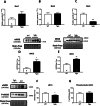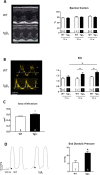Overexpression of endothelial β3 -adrenergic receptor induces diastolic dysfunction in rats
- PMID: 33034410
- PMCID: PMC7754894
- DOI: 10.1002/ehf2.13040
Overexpression of endothelial β3 -adrenergic receptor induces diastolic dysfunction in rats
Abstract
Aims: Diastolic dysfunction is common in cardiovascular diseases, particularly in the case of heart failure with preserved ejection fraction. The challenge is to develop adequate animal models to envision human therapies in the future. It has been hypothesized that this diastolic dysfunction is linked to alterations in the nitric oxide (• NO) pathway. To investigate this issue further, we investigated the cardiac functions of a transgenic rat model (Tgβ3 ) that overexpresses the human β3 -adrenoceptor (hβ3 -AR) in the endothelium with the underlying rationale that the • NO pathway should be stimulated in the endothelium.
Methods and results: Transgenic rats (Tgβ3 ) that express hβ3 -AR under the control of intercellular adhesion molecule 2 promoter were developed for a specific expression in endothelial cells. Transcriptomic analyses were performed on left ventricular tissue from 45-week-old rats. Among all altered genes, we focus on • NO synthase expression and endothelial function with arterial reactivity and evaluation of • NO and O2 •- production. Cardiac function was characterized by echocardiography, invasive haemodynamic studies, and working heart studies. Transcriptome analyses illustrate that several key genes are regulated by the hβ3 -AR overexpression. Overexpression of hβ3 -AR leads to a reduction of Nos3 mRNA expression (-72%; P < 0.05) associated with a decrease in protein expression (-19%; P < 0.05). Concentration-dependent vasodilation to isoproterenol was significantly reduced in Tgβ3 aorta (-10%; P < 0.05), while • NO and O2 •- production was increased. In the same time, Tgβ3 rats display progressively increasing diastolic dysfunction with age, as shown by an increase in the E/A filing ratio [1.15 ± 0.01 (wild type, WT) vs. 1.33 ± 0.04 (Tgβ3 ); P < 0.05] and in left ventricular end-diastolic pressure [5.57 ± 1.23 mmHg (WT) vs. 11.68 ± 1.11 mmHg (Tgβ3 ); P < 0.05]. In isolated working hearts, diastolic stress using increasing preload levels led to a 20% decrease in aortic flow [55.4 ± 1.9 mL/min (WT) vs. 45.8 ± 2.5 mL/min (Tgβ3 ); P < 0.05].
Conclusions: The Tgβ3 rat model displays the expected increase in • NO production upon ageing and develops diastolic dysfunction. These findings provide a further link between endothelial and cardiac dysfunction. This rat model should be valuable for future preclinical evaluation of candidate drugs aimed at correcting diastolic dysfunction.
Keywords: Diastolic dysfunction; Endothelium; HFpEF; Nitric oxide production; Rat model; Transcriptome; β3-Adrenoceptor.
© 2020 The Authors. ESC Heart Failure published by John Wiley & Sons Ltd on behalf of the European Society of Cardiology.
Conflict of interest statement
None declared.
Figures






Similar articles
-
The Endothelial Dysfunction Could Be a Cause of Heart Failure with Preserved Ejection Fraction Development in a Rat Model.Oxid Med Cell Longev. 2022 May 18;2022:7377877. doi: 10.1155/2022/7377877. eCollection 2022. Oxid Med Cell Longev. 2022. PMID: 35633883 Free PMC article.
-
High-intensity interval training attenuates endothelial dysfunction in a Dahl salt-sensitive rat model of heart failure with preserved ejection fraction.J Appl Physiol (1985). 2015 Sep 15;119(6):745-52. doi: 10.1152/japplphysiol.01123.2014. Epub 2015 Jul 30. J Appl Physiol (1985). 2015. PMID: 26229002
-
[Vascular beta-adrenergic remodeling in rat transgenic model over-expressing endothelial beta3-adrenoceptors].Arch Mal Coeur Vaiss. 2005 Jul-Aug;98(7-8):836-40. Arch Mal Coeur Vaiss. 2005. PMID: 16220757 French.
-
Low-intensity pulsed ultrasound ameliorates cardiac diastolic dysfunction in mice: a possible novel therapy for heart failure with preserved left ventricular ejection fraction.Cardiovasc Res. 2021 Apr 23;117(5):1325-1338. doi: 10.1093/cvr/cvaa221. Cardiovasc Res. 2021. PMID: 32683442
-
A novel paradigm for heart failure with preserved ejection fraction: comorbidities drive myocardial dysfunction and remodeling through coronary microvascular endothelial inflammation.J Am Coll Cardiol. 2013 Jul 23;62(4):263-71. doi: 10.1016/j.jacc.2013.02.092. Epub 2013 May 15. J Am Coll Cardiol. 2013. PMID: 23684677 Review.
Cited by
-
Molecular Mechanisms and Therapeutic Implications of Endothelial Dysfunction in Patients with Heart Failure.Int J Mol Sci. 2023 Feb 21;24(5):4321. doi: 10.3390/ijms24054321. Int J Mol Sci. 2023. PMID: 36901752 Free PMC article. Review.
-
Mimicking Metabolic Disturbance in Establishing Animal Models of Heart Failure With Preserved Ejection Fraction.Front Physiol. 2022 May 3;13:879214. doi: 10.3389/fphys.2022.879214. eCollection 2022. Front Physiol. 2022. PMID: 35592030 Free PMC article. Review.
-
Endothelial Dysfunction in Heart Failure With Preserved Ejection Fraction: What are the Experimental Proofs?Front Physiol. 2022 Jul 8;13:906272. doi: 10.3389/fphys.2022.906272. eCollection 2022. Front Physiol. 2022. PMID: 35874523 Free PMC article. Review.
-
Implications of a Soy-Based Diet for Animal Models.Int J Mol Sci. 2021 Jan 14;22(2):774. doi: 10.3390/ijms22020774. Int J Mol Sci. 2021. PMID: 33466650 Free PMC article.
-
Pharmacological Effects of Methotrexate and Infliximab in a Rats Model of Diet-Induced Dyslipidemia and Beta-3 Overexpression on Endothelial Cells.J Clin Med. 2021 Jul 16;10(14):3143. doi: 10.3390/jcm10143143. J Clin Med. 2021. PMID: 34300308 Free PMC article.
References
-
- Dunlay SM, Roger VL, Redfield MM. Epidemiology of heart failure with preserved ejection fraction. Nat Rev Cardiol 2017; 14: 591–602. - PubMed
-
- Ponikowski P, Voors AA, Anker SD, Bueno H, Cleland JGF, Coats AJS, Falk V, Gonzalez‐Juanatey JR, Harjola VP, Jankowska EA, Jessup M. 2016 ESC guidelines for the diagnosis and treatment of acute and chronic heart failure. Rev Espanola Cardiol Engl Ed 2016; 69: 1167. - PubMed
-
- Westermann D, Kasner M, Steendijk P, Spillmann F, Riad A, Weitmann K, Hoffmann W, Poller W, Pauschinger M, Schultheiss HP, Tschöpe C. Role of left ventricular stiffness in heart failure with normal ejection fraction. Circulation 2008; 117: 2051–2060. - PubMed
Grants and funding
LinkOut - more resources
Full Text Sources
Molecular Biology Databases
Research Materials

